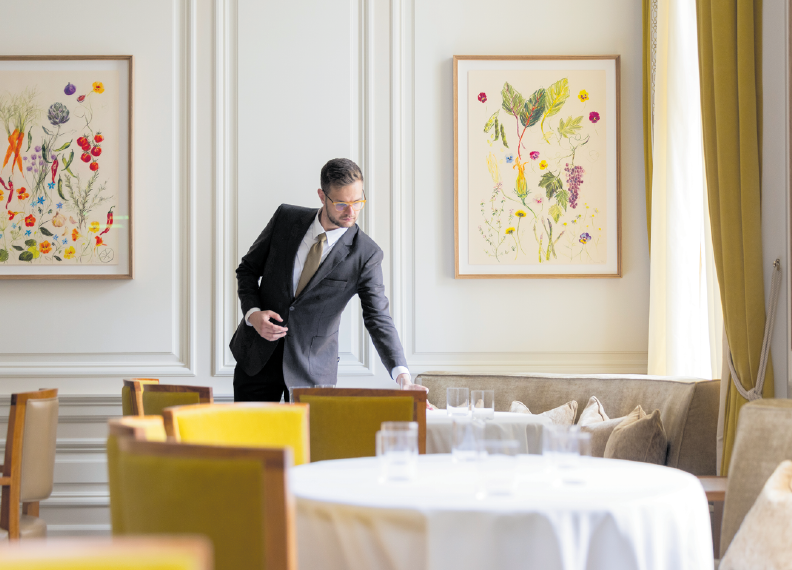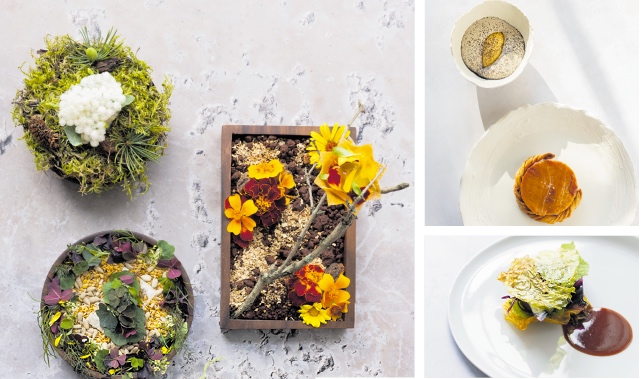
Mauro Colagreco at the Old War Office at Raffles London – or just plain old Mauro to its friends – is the kind of place where the bread comes with a poem. It’s less a restaurant than it is a wry comment on the very concept of restaurants, a philosophical rumination on what it means to eat dinner, a sharply observed piece of avant garde theatre in which food is the medium rather than the message.
Of the nine restaurants housed in the £1.4bn development, Mauro is the fanciest, overseen by the eponymous Argentinian chef Mauro Colagreco, who runs the three Michelin starred Restaurant Mirazur on the French Riviera (it topped the World’s 50 Best list from 2019 to 2021). Chef knows his onions.
The whitewashed dining room is a light and breezy take on the kind of Victorian members’ club you could imagine Dorian Gray and Lord Henry Wotton hanging out in before getting stuck into the opium, all intricate cornicing and carpets as deep as quicksand.
Even the layout gives Mauro the air of a theatrical production: at the banana-shaped banquettes, you’re seated side by side, looking not at your guest but out at the restaurant, as if your role here is to observe as much as it is to eat. I had a perfect view of the only other guests, two spectacularly dressed young Chinese couples who both spent their entire meal taking photograph after photograph in doleful silence. The lack of background chatter coupled with the sheer volume of still air hanging in the high-ceilinged room creates an intense, slightly surreal atmosphere.
The menu “traces a path through the English countryside” and “reveals” no fewer than 70 vegetables. I went for the “land and sea” tasting menu, which features five courses, each one of them quite mad, plus various amuse-bouches and petit fours. For that you’ll pay £165 each, with the more basic of the wine pairings ringing in at £125. Not cheap, but what did you expect?
The amuse-bouches arrive in what look like wooden terrariums, one filled with sprigs of pine, the next with dried seaweed, another with some kind of moss. Once you carefully extract the edible parts you’ll find a perfectly lovely celeriac and granny smith tartlet, a dainty little potato cannoli (made, somehow, with spun spaghetti), and something that looked like seaweed but was in fact made from sunflower seeds, all of them disappearing in what must be a depressing fraction of the time they took to make.
The first proper course is a spectacular magenta creation featuring various forms of forced Yorkshire rhubarb. This is a vegetable, raised in candlelit basements, that grows so quickly as it searches desperately for sunlight that it squeaks and pops in apparent pain, the vegan equivalent of foie gras. The dish features cubes of rhubarb, strips of rhubarb, a rhubarb ragu, rhubarb granita. Underneath all that is mascarpone, and under that… an oyster. An oyster? In mascarpone, under rhubarb? Yes, an oyster, in mascarpone, under rhubarb. And you know what – it’s really, really good, a tart, creamy, icy combination of flavours and textures that should never be allowed together on a plate, not in any sane world, but it somehow works. Please don’t try this at home.

Did I mention that each course comes with its own illustration? When the dishes are delivered, a little botanical diagram is propped on your table, allowing you to really get into the mindset of your radicchio and citrus fruit and rhubarb.
I have a theory: every time the team at Mauro were required to make a decision, the answer was always “more”.
There are two servings of bread, for instance, and I think the conversation in the kitchen must have gone something like this:
“But chef, two lots of bread is too much!”
“Of course it is – let’s give them a whole loaf. Each! And while you’re at it, print out a poem about bread and give them that, too.”
When the “lettuce” course is delivered, two waiters perform a synchronised pour of the vermouth sauce, and while this isn’t unusual in fancy restaurants, it was delivered with such balletic precision I almost expected them to break character and give a little wink to camera. The lettuce tasted great in the way really nice charred lettuce just tastes great, the haddock nestled beneath giving it a subtle, smoky twang.
“Citrus” is made up of a piece of monkfish topped with curried pumpkin and orbited by artfully placed blobs of citrus curd – more mad, punchy flavours. Then there was venison, entirely hidden beneath a shell of radicchio and topped with a beetroot and raspberry jus: as perfect a piece of meat as you could hope for. Spot on.
To round it off there’s a chocolate dessert with rosemary ice cream and more petit fours than I have the will or inclination to describe, including the inevitable spherification, a gelatinous, womb-like ball of liquid that always shows up at some point in places like this.
I’ve reviewed hundreds of restaurants for this newspaper but I’m struggling to come up with a coherent opinion of Mauro. The normal rules don’t seem to apply. Up is down, black is white, oysters go with rhubarb.
On the one hand, it feels like Mauro is trying incredibly hard to live up to its surroundings, and in attempting to create something unique and memorable and Instagrammable, it ends up so overwrought that it borders on the absurd. On the other hand, I unashamedly loved the procession of fussy little dishes, each one a minor miracle of chemistry and engineering.
You should try it at least once – probably exactly once.




